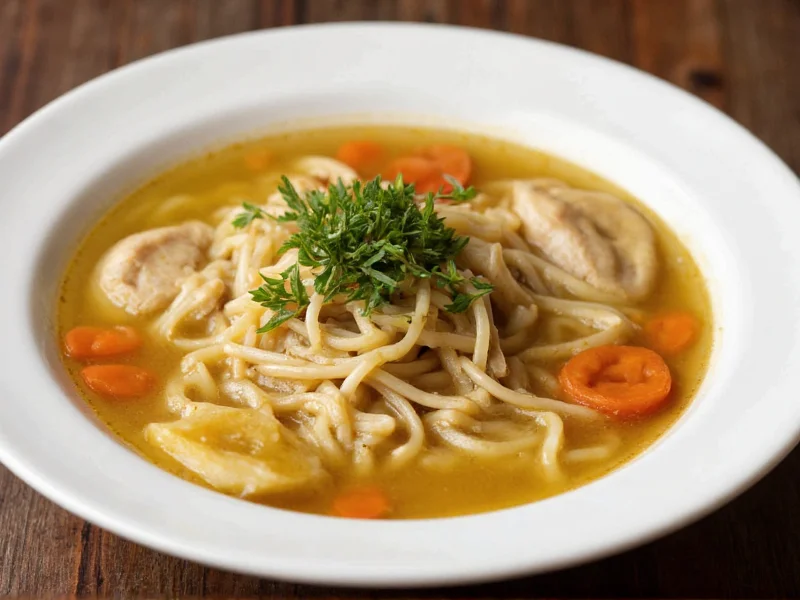Choosing the right noodles transforms your chicken noodle soup from ordinary to extraordinary. The perfect noodle balances texture, flavor absorption, and cooking properties to complement the broth without overwhelming it. Many home cooks make the mistake of using whatever noodles they have on hand, only to end up with either mushy strands or undercooked pasta that ruins the soup's harmony.
Why Noodle Selection Matters for Chicken Noodle Soup
The right noodles enhance rather than dominate your soup. Chicken noodle soup requires noodles that can withstand simmering in broth while maintaining structural integrity. Unlike standalone pasta dishes, soup noodles must interact thoughtfully with liquid, vegetables, and proteins. The ideal noodle absorbs just enough flavor to complement the broth without becoming waterlogged or disintegrating.
Key Factors in Choosing Soup Noodles
Three critical elements determine noodle suitability for chicken noodle soup:
| Factor | Why It Matters | Optimal Characteristic |
|---|---|---|
| Texture resilience | Noodles must maintain structure in hot broth | Firm yet tender bite after cooking |
| Flavor absorption | Noodles should complement, not overpower, broth | Moderate absorption capacity |
| Cooking time | Must align with soup preparation timeline | 7-10 minutes in simmering broth |
Top Noodle Options for Chicken Noodle Soup
Egg Noodles: The Classic Choice
Egg noodles remain the gold standard for traditional chicken noodle soup. Their slightly richer flavor and yellow hue come from egg content, which also provides structural strength. When selecting egg noodles, consider width:
- Medium-width (1/4 inch): Perfect balance for most recipes - holds shape while absorbing broth
- Wide (1/2 inch): Ideal for chunky, hearty soups with substantial vegetables
- Fine (1/8 inch): Best for delicate broths or when serving to children
Alternative Noodle Options
While egg noodles reign supreme, several alternatives work well in specific contexts:
| Noodle Type | Best For | Cooking Tip |
|---|---|---|
| Homemade egg noodles | Authentic, from-scratch preparation | Cook directly in broth for maximum flavor integration |
| Dried Chinese wheat noodles | Asian-inspired variations | Rinse after cooking to prevent sticking |
| Small pasta shapes | Quick weeknight meals | Add during last 5 minutes of cooking |
Noodles to Avoid in Chicken Noodle Soup
Certain noodles compromise soup quality due to texture issues or incompatible cooking properties. Avoid these common mistakes:
- Long spaghetti or fettuccine: Difficult to eat in soup format and overpowers other ingredients
- Fresh pasta: Typically too delicate and becomes mushy quickly
- Ramen noodles (unless specifically making ramen-style soup): Overpowering flavor and inconsistent texture
- Overly thick udon: Dominates the bowl and doesn't complement traditional chicken soup flavors
Professional Cooking Techniques for Perfect Soup Noodles
Even the best noodles can fail with improper preparation. Follow these chef-recommended techniques:
Timing is Everything
Add noodles during the final stages of cooking. For dried noodles, introduce them when soup is nearly finished and simmer just until tender. Overcooking is the most common error that turns perfect noodles into soup glue.
Prevent Mushy Noodles in Leftovers
Noodles continue cooking in hot broth. For meal prep, cook noodles separately and add to individual portions when serving. Store broth and noodles separately for up to three days for optimal texture in reheated soup.
Dried vs. Fresh Noodle Considerations
Dried noodles generally perform better in soup applications than fresh varieties. The drying process creates a more resilient structure that withstands prolonged exposure to liquid. If using fresh noodles, reduce cooking time by 30-50% compared to package instructions.
Dietary Adaptations Without Compromising Quality
Special dietary needs don't require sacrificing noodle quality. These alternatives maintain integrity in soup:
- Gluten-free egg noodles: Look for brands with xanthan gum for better texture
- Whole wheat noodles: Choose 100% whole grain varieties with sufficient egg content
- Zucchini noodles: Add during final minute of cooking for low-carb option
When adapting recipes, remember that alternative noodles often require adjusted cooking times. Test one strand for doneness rather than relying strictly on package instructions.
Perfecting Your Chicken Noodle Soup Noodle Selection
The ideal noodle enhances your soup without drawing attention to itself. Medium-width egg noodles provide the most reliable results for traditional chicken noodle soup, offering the perfect balance of texture and flavor absorption. For best results, choose high-quality dried egg noodles with visible yellow color indicating proper egg content. Remember that proper cooking technique matters as much as noodle selection—add noodles late in the process and avoid overcooking for restaurant-quality results at home.











 浙公网安备
33010002000092号
浙公网安备
33010002000092号 浙B2-20120091-4
浙B2-20120091-4